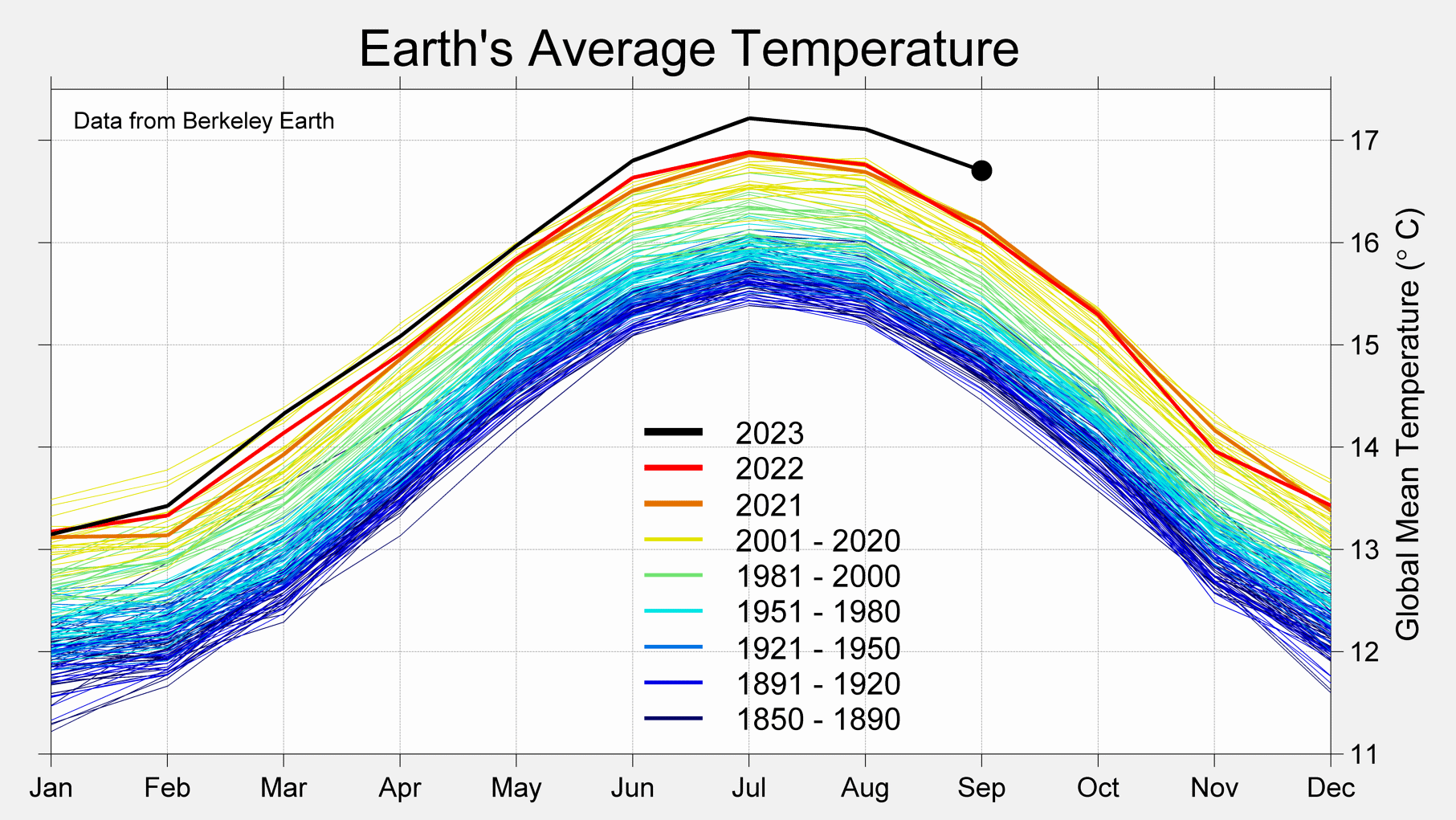Over the last few weeks, a new scholarly term has appeared in the lexicon of climate science: gobsmackingly bananas. The phrase was coined by a leading climate scientist, Zeke Hausfather, to describe the outcome of a new analysis of global warming by him and his colleagues at Berkeley Earth. The work reveals a sharp global spike in air temperature this past September, setting a new record for the month and, incredibly, exceeding the old record by nearly a full degree Fahrenheit. Writing in The New York Times, Dr. Hausfather unflinchingly describes the new data, noting that it reflects an acceleration (rather than a steady increase) of global warming over the past 15 years, and raises the level of urgency for decarbonization efforts. Anyone with a sense of concern or alarm about the climate crisis should take note of the messages emerging from this new study, as they are likely to have considerable influence on the public conversation.
Berkeley Earth is an open-source nonprofit that offers independent analyses of environmental data, including tracking changes in temperatures of the atmosphere and surface ocean. The primary data consists of tens of thousands of measurements of air temperature at land-based weather stations, and sea surface temperatures taken throughout the world’s oceans. After its founding in 2010, the Berkeley Earth team applied its analytic techniques to these data, looking at potential systematic errors in the way measurements had been made. This helped address legitimate concerns about data biases that might have affected the conclusions about global warming used by policymakers in the US and worldwide. More recently, the team has made improvements in climate analysis by developing new approaches to combine data from individual weather stations. The resulting plots of global or regional surface temperature increases over time are compared with independent data from other climate science teams at NASA and elsewhere. The studies are in strong agreement, giving confidence in the reliability of the approach.
The new Berkeley Earth study is simply titled “September 2023 Temperature Update.” It reports that September 2023 was the warmest September since modern temperature records began in 1850, with most of the warming showing up in the polar regions, especially Antarctica. Not surprisingly, a new record low was also set for the extent of Antarctic sea ice. Although several months remain in 2023, the team is virtually certain, with over 99% confidence, that this year will be the warmest ever recorded.
The fossil fuel-based energy economy certainly is the major cause of global warming, but the Berkeley Earth study and other analyses show that at least two other factors contribute to the recent temperature spike. One of these is natural variability, which appears prominently this year in the form of the recurring El Niño climate pattern in the tropical Pacific Ocean. El Niño and its counterpart, La Niña, reflect a naturally occurring coupling between atmospheric winds and ocean temperatures in the tropical Pacific. In El Niño years, the ocean surface warms, which shows up in the measured temperatures. NOAA officially declared the onset of the latest El Niño this June; if past trends are any guide, the phenomenon will strengthen next year, producing an even hotter sea surface. This does not bode well for global temperatures in 2024.
The second factor underlying the temperature spike is a decrease in atmospheric aerosols coming from the use of less polluting fuels. In 2015, the International Maritime Organization imposed limits on the sulfur content of diesel oils that power commercial shipping, rules that were further strengthened a few years ago. When burned, the sulfur in these fuels ends up as sulfur-containing aerosols in the atmosphere, which decrease the reflectivity of clouds to incoming sunlight. The higher proportion of absorbed sunlight then worsens the already bad energy imbalance caused by greenhouse gas emissions. New air pollution rules in places like China and India have contributed further to the decrease in atmospheric aerosols. As fossil fuels are phased out in earnest over the next few decades, the cooling effect of aerosols will continue to decrease alongside the drop in CO2 emissions. We have known about this unmasking effect for a long time, but this appears to be the moment when its impact has clearly emerged.
Another finding of Berkeley Earth’s September temperature update is that, with 90% probability, 2023 temperatures will be 1.5°C above the baseline set by the average surface temperature between 1850 and 1900 for the first time. 1.5°C is the aspirational target set in the Paris Agreement, which many engaged individuals and organizations have set a great deal of store by. If we indeed go over 1.5°C for the 2023 year, will it mean that humanity has just blown through the Paris limit? No, because one outlying high-temperature year would represent just a single data point in a multi-year temperature record that extends back over a hundred years. Instead, we will reach the Paris limit when successive years are about as likely as not to exceed 1.5°C. Most models now show that happening in about a decade.
In his New York Times piece, Dr. Hausfather explained that while the September temperature spike was unprecedented, it nevertheless fell well within the range of projections generated by the climate models. In other words, a perfect storm of still increasing greenhouse gas emissions, an El Niño year, and declining amounts of cooling aerosols was bound to produce something like this in the near term. The longer-term projections of the models are thus still reliable, and they can continue to offer sound guidance for aggressive climate policies to achieve net-zero emissions by mid-century. The temperature spike was a well anticipated bump in the road, and there is no reason to panic.
All well and good for the portion of the American public that pays attention to the data and already trusts in policies based on science. I share Dr. Hausfather’s expressed hope that the strong performance of the climate models will increase that public share, but we would do well to anticipate what the reaction will be like in January, when “hottest year ever” is sure to dominate the headlines. That message will appear to vindicate the doomist point of view that action is futile. Other parts of the story will challenge public understanding because they depend on more nuanced arguments. Fossil fuels still have to be phased out, even though doing so removes the cooling aerosols. We passed the 1.5°C limit, but only for this year. It is not difficult to imagine how these messages might be bent to ideological ends, by doomists and denialists alike.
If there are any marching orders coming from this study, they surely must include a redoubling of efforts to educate laypersons and policymakers alike in the basics of climate science. For many years now, the Yale Program in Climate Change Communications (YPCCC) has performed an invaluable service by conducting detailed public opinion surveys on climate matters, looking at beliefs and attitudes, politics, policy preferences, and social justice. The good news is that significant majorities of the American public believe that global warming is occurring, is human-caused, and that there is still time to do something about it. There is also strong support for renewable energy investment, even in the most conservative parts of the country. All this would seem to undercut the denialist and doomist positions. The problem is that the 11% of Americans who are dismissive of global warming and endorse conspiracy theories have grossly outsized influence in national politics. Their strong sway on Republican party attitudes limits our national response to the climate crisis, while structural issues in the American political system, like winner-take-all primaries, enhance the influence of small minorities with extremist views.
In a recent interview, YPCCC director Anthony Leiserowitz emphasized how a phenomenon called the “veil of knowledge” can block the effective communication and education about climate that is so important now. Normally we think about cognitive bias as common in groups that reject climate science, like doomists whose belief in human decline leads them to exaggerate the severity of climate change impacts (Earthward, July 6). But the veil of knowledge is a cognitive bias that applies to people who do accept science. It says that once we know the facts about something, it becomes much more difficult to appreciate that others remain ignorant. We readily assume that others know what we do, yet they don’t. I myself experienced this with a shock while reading a recent article in Politico about a new tactic of right-wing denialists: shaming public officials who promote climate policy by revealing their ignorance of the facts. In committee hearings, House Republican Doug LaMalfa was able to stump both Transportation secretary Pete Buttigieg and Interior secretary Deb Haaland, neither of whom knew the concentration of carbon dioxide in the atmosphere. Really, Presidential Cabinet members with climate-relevant portfolios didn’t know such a basic fact? Yes, really.
The veil of knowledge can be overcome with awareness and effort, and that work will be important for those of us seeking to influence lawmakers, business leaders or friends and family to take a more climate-conscious view. Of course, the potential for this bias shouldn’t stop us from learning as much we can. Doug LaMalfa’s stunt notwithstanding, Secretaries Haaland and Buttigieg occupy positions where they can execute healthy climate policies whether they understand the science or not. But effectiveness as a citizen advocate is enhanced by having the confidence that comes from knowing the facts. Releases of new climate findings like the Berkeley Earth report are teachable moments where a little knowledge can go a long way.
___________________________________
https://berkeleyearth.org/september-2023-temperature-update/
https://www.nytimes.com/2023/10/13/opinion/climate-change-excessive-heat-2023.html
https://climate.nasa.gov/explore/ask-nasa-climate/3071/the-raw-truth-on-global-temperature-records/
https://www.theclimatebrink.com/p/will-2023-be-the-first-year-above
https://www.eco-business.com/news/state-of-the-climate-how-the-world-warmed-in-2021/
https://www.climate.gov/news-features/blogs/enso/rise-el-niño-and-la-niña
https://www.columbia.edu/~jeh1/mailings/2023/FlyingBlind.14September2023.pdf
https://www.energypolicy.columbia.edu/climate-change-in-the-american-mind/
https://www.eenews.net/articles/quiz-show-gop-deploys-new-climate-messaging-tactic/

